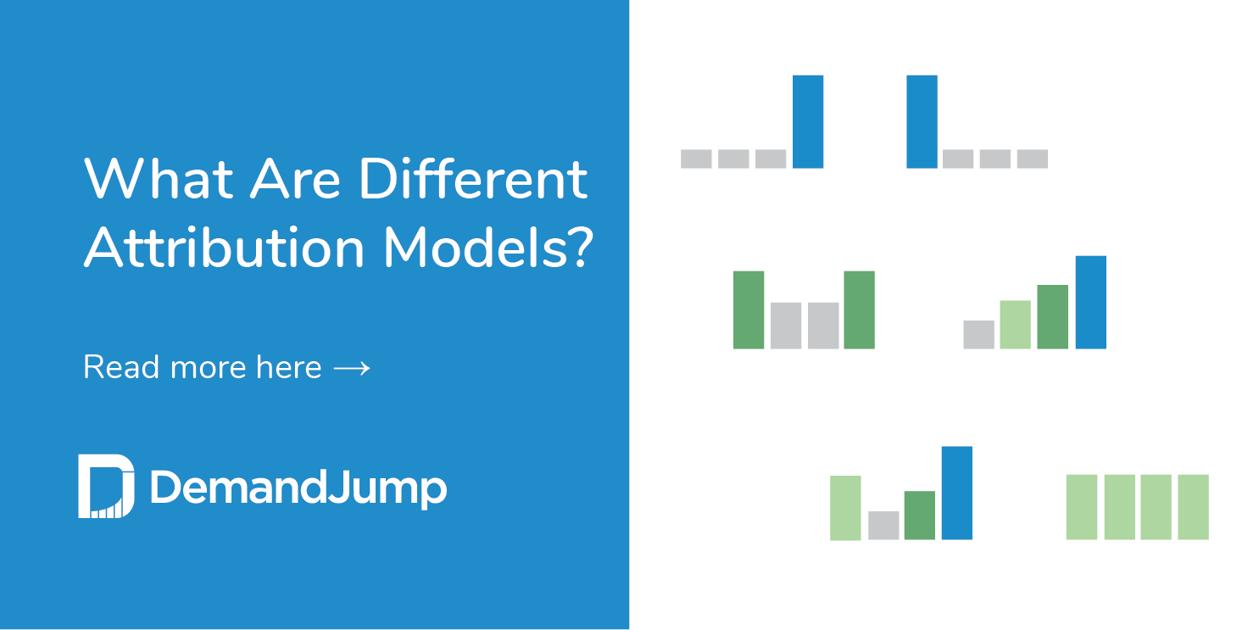What are Different Attribution Models?
January 8, 2021 •DJ Team

An attribution model isn’t something you build with rubber cement and paint. Rather, it’s the process a marketing team sets up to determine which pieces of content are responsible for achieving their marketing goals. This lets teams make more informed decisions about marketing efforts and budget.
However, the information a team gains from marketing attribution is dependent on the model the team uses to analyze data. Depending on the information you collect, and how it is represented, different attribution models can tell you very different things about the same marketing campaign.
Here’s what you need to know about some of the best attribution models in use today, and when each can be most effective to drive marketing success.
What is the Most Common Attribution Model?
When marketing attribution started before the days of the Internet, it was largely conducted on a single-touch basis. This means giving all the credit for a customer’s purchase decision to one piece of marketing content, whether a billboard, commercial, or online content.
While single-touch attribution is still common today, multi-touch attribution has also emerged as the customer journey has become more complex. With consumers today looking at lots of content across multiple devices and mediums, giving credit to several pieces of marketing content has become more important to fully understand what is working well.
It’s estimated that at least 85% of companies in the US are using marketing attribution of some kind, and among that number, more than half are using multi-touch attribution.

What is Last Touch Attribution?
Last touch attribution is an example of some of the simplest marketing attribution that can be set up. In last-touch attribution, the full credit for the sales opportunity is given to the last piece of content the customer engaged with. This could be an email, digital ad, web page, blog post, or any other content in the strategy.
One benefit of last-touch attribution is that it leaves little room for error where time is concerned. Most cookies expire after a certain window of time, meaning customer data may be lost if a certain amount of time passes between the customer’s engagement with the content and their purchase decision. With last-touch attribution, this is less of a risk than in multi-touch models.
On the flip side, last-touch attribution doesn’t make it clear how effective other content has been at influencing the customer’s buying decision. The customer might ultimately make a purchase by clicking on a digital ad that was sent to them through retargeting. But the content they saw on the website might really be what convinced them to make a purchase. This is just a simple example of how last-tough attribution might not tell the full story.
What are Time Decay Options and Strategies for Marketing Attribution?
Time decay attribution is a multi-touch attribution model that takes into account the length of time the customer has been on their journey to a purchase decision. As a multi touch model, time decay options do take into account the many pieces of content a user has viewed along the way.
However, this model gives less credit to marketing content the farther back in time the user interacted with it. The time decay attribution strategy is based on the assumption that the earlier touches in the marketing funnel did less to convince the buying decision than content consumed later.
For instance, an organic search may lead a potential customer to click on your website, but they don’t make a buying decision. A few days later, content on a social media feed directs them to your website again. They finally make a buying decision a few days later when a digital ad informs them of a promotion. In this case, most of the credit would go to the digital ad, and the other pieces of content on your website and social media would get lesser amounts of credit the further back in time they are.
However, many marketers might tell you that the organic search click that gained the customer’s initial interest was the hardest part of all and deserves more than a marginal amount of credit. This is an example of how a time decay strategy can also give less credit to content in the marketing library than it deserves.
What is a Revenue Attribution Model?
Revenue attribution models bring the ultimate goal of marketing attribution into reality. Revenue attribution bridges the gap between sales and marketing, matching specific marketing costs to the revenue they generate. This is different from other approaches to digital marketing attribution, because it isn’t just internal to the marketing department, but also draws in the sales team.
The strategy also usually integrates offline advertising, customer testimonials about their experience, and word-of-mouth marketing. Revenue attribution ties marketing strategies to the ROI of marketing and allows some of the speculation to be removed from marketing by keeping revenue top-of-mind.
Automated Multi Touch Attribution with Machine Learning
With tools like DemandJump, marketers and key stakeholders go from a reactionary position to a proactive position. By generating insights from one central hub, the complexities of marketing attribution are reduced, leaving you with more time to take action on the results.
Try it for free and take action on the insights already living in your data.
Featured Articles
Categories
- Attribution Tracking (13)
- Channel Optimization (11)
- Consumer Insights (68)
- Content Marketing (251)
- Data Science (8)
- Digital Marketing (6)
- Digital Transformation (26)
- Enterprise (10)
- Lead Generation (14)
- Market Intelligence (8)
- Marketing Analytics (39)
- Marketing Attribution (57)
- Marketing Management (153)
- Marketing Operations (86)
- Organic Search (222)
- Paid Search (52)
- Pillar-Based Marketing (63)
- Programmatic Advertising (9)
- SaaS Content (14)
- SaaS Marketing (29)
- Search Marketing (111)
- SEO Keyword Research (28)
- SEO Pillar (18)
- SEO Strategy (46)
- SMB (5)
- Website Content (12)


